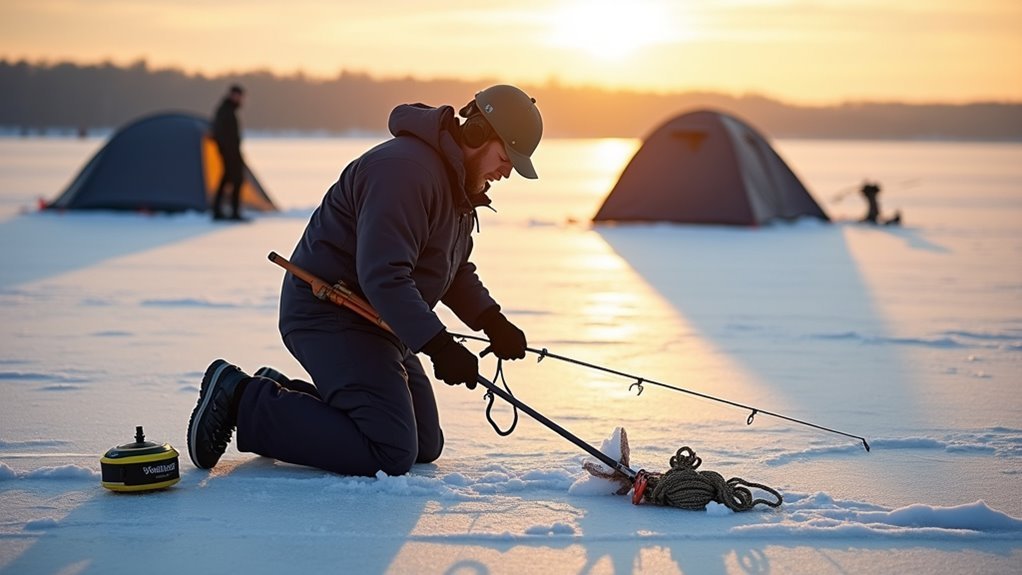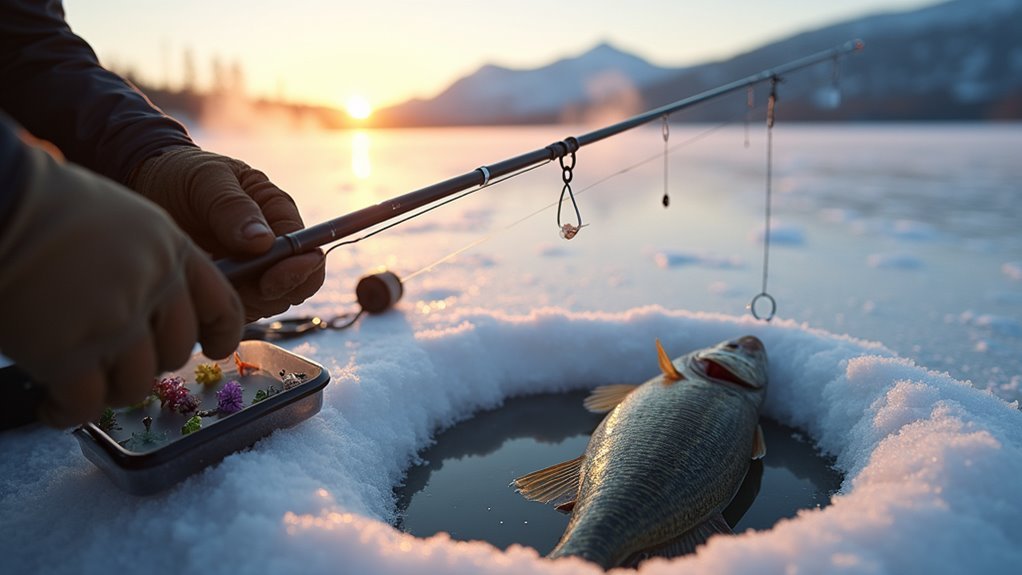Master ice fishing by prioritizing safety first—always check ice thickness and carry safety gear. You’ll need a medium-light action rod, quality line, and an auger to get started. Find fish by targeting underwater structures and depth changes. Perhaps the most important skill is mastering species-specific jigging techniques: subtle for walleye, rapid for perch. Live bait works wonders when fish are sluggish, while artificial lures offer convenience. The right timing can turn a slow day into an exceptional outing.
Essential Ice Fishing Safety Precautions

Anyone venturing out for ice fishing must prioritize safety above all else. I think many enthusiasts get caught up in the excitement and forget that ice can be unpredictable.
Always carry ice picks, a long rope, and a flotation device—these aren’t optional extras.
Before stepping onto frozen water, check ice thickness. You’ll need at least 4 inches for walking and more for vehicles.
Perhaps the most overlooked safety tip is telling someone where you’re going and when you’ll return.
Dress in layers, avoiding cotton, which stays wet when soaked.
And remember, conditions can change quickly, so trust your instincts if something feels off.
Selecting the Right Gear for Winter Success
A well-stocked tackle box sits at the heart of every successful ice fishing expedition. You’ll want to prioritize quality over quantity, focusing on essentials that perform in frigid conditions.
I think an 18-24 inch medium-light action rod paired with a small reel spooled with 4-6 pound test line gives you versatility for most situations.
Don’t overlook the importance of good augers – electric ones are perhaps easier to manage than gas models, especially in bitter cold.
Your auger choice can make or break an ice fishing trip—go electric for easier performance when temperatures plummet.
And remember those small details like ice skimmers and spring bobbers that really make a difference. Quality gloves are non-negotiable; your fingers will thank you later!
Finding Prime Fishing Locations on Frozen Lakes
When you’re standing on a vast frozen lake, knowing where to drill your holes can make the difference between a productive day and hours of frustration.
I think the best approach is to look for structure beneath the ice – drop-offs, weed beds, and underwater points tend to concentrate fish.
Lake maps are incredibly helpful here. Check for depth changes where fish often gather, especially during winter.
Don’t hesitate to drill test holes in promising areas, and perhaps most importantly, observe other anglers’ success.
Fish finders with GPS capabilities can be worth their weight in gold when you’re trying to pinpoint those elusive hotspots. Additionally, integrating advanced maps with your fish finder enhances your understanding of underwater landscapes and helps you make more informed fishing decisions.
Effective Jigging Techniques for Different Species

Jigging through the ice requires mastering different techniques depending on your target species.
For walleye, try a subtle lift-and-fall motion with 5-10 second pauses between movements. They’re often attracted to this methodical approach.
Perch respond best to rapid, short jiggles that mimic injured baitfish. I’ve found maintaining your jig about a foot off the bottom works wonderfully for these curious fish.
Quick, tight jiggles about a foot off the bottom will turn curious perch into eager biters.
When targeting pike, use larger, more aggressive movements with longer pauses.
Perhaps the most important thing with any species is watching your spring bobber closely – those bites can be incredibly subtle, especially on colder days.
Live Bait vs. Artificial Lures: What Works Best
The eternal debate among ice anglers often centers on one essential question: should you use live bait or artificial lures?
In my experience, both have their place on the ice.
Live bait—particularly minnows—tends to outperform when fish are less active. They provide natural movement and scent that hesitant fish find irresistible.
Perhaps the most compelling reason to use live bait is its effectiveness with walleye and perch.
Artificial lures shine when you’re targeting active fish or need to cover water quickly. They’re certainly more convenient too—no need to worry about keeping bait alive in freezing conditions!
Peak Fishing Times to Maximize Your Catch
Timing can make all the difference between a frustrating day on the ice and filling your bucket with fish. I’ve found that different species have distinct feeding patterns, which you’ll need to understand to maximize your success.
| Species | Prime Time | Preferred Depth |
|---|---|---|
| Walleye | Dawn/Dusk | 15-25 feet |
| Perch | Mid-morning | 8-15 feet |
| Pike | Late morning | 5-15 feet |
| Trout | Early afternoon | Variable |
Perhaps the most overlooked factor is barometric pressure—fish tend to be more active right before a weather change. Remember, patience matters too; sometimes you’ll need to wait out those slow periods.
Frequently Asked Questions
How Do I Prevent My Fishing Line From Freezing?
To prevent your fishing line from freezing, apply silicone spray or line conditioner before fishing. Keep extra line inside your jacket, and periodically clear ice from guides with anti-freeze paste.
Can I Use the Same Hole for Multiple Days?
Like a familiar pathway through a winter wilderness, your ice hole can remain usable for multiple days if you maintain it and cover it overnight to prevent complete freezing.
What’s the Best Way to Transport Fish While Ice Fishing?
Use insulated fish bags or buckets with water to keep your catch fresh. You’ll want to clean them quickly or use slush from the ice hole to maintain their quality.
How Can I Keep My Hands Warm While Still Maintaining Dexterity?
Nearly 40% of anglers cite cold hands as their top complaint. You’ll stay dexterous by using thin liner gloves under fingerless mittens, keeping hand warmers in your pockets, and occasionally warming hands by your core.
Should I Pre-Drill Holes Early or Drill as Needed Throughout the Day?
Pre-drill several holes early morning to minimize noise disturbance, then drill as needed. You’ll save time when fish are active and won’t scare them away with excessive drilling throughout the day.